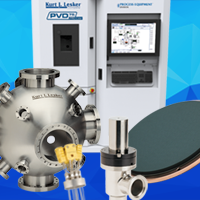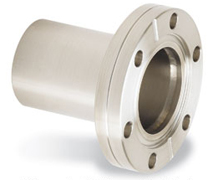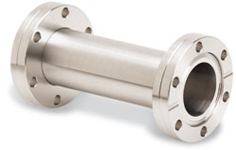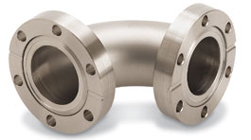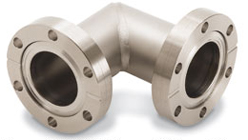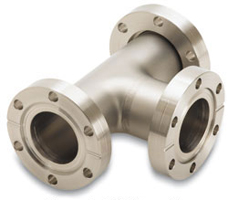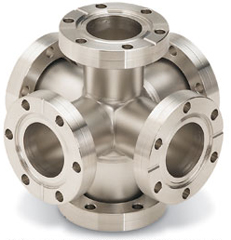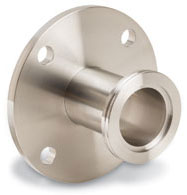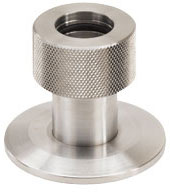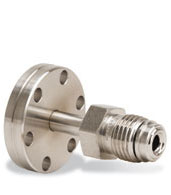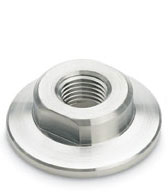Flanged Components & Fittings Technical Notes
Fittings
Vacuum fittings are, essentially, conveniently shaped, flanged devices that can be assembled into complete vacuum envelopes.
While nominally identical fittings from different manufacturers will be similar, there may be small length differences. Where possible, vacuum systems should be designed so they are insensitive to small length changes.
The common construction materials for fittings are 304 stainless and aluminum; however, fittings may be available in 316 stainless.
The pressure and temperature range of any fitting is dictated by the construction material and the flange type. For example, a 304L stainless fitting with CF flanges and copper gaskets is compatible with <1 x 10-13 Torr (<1.3 x 10-13 mbar) and 450°C. An aluminum fitting with fluorocarbon gaskets is compatible with ~10-8 Torr or mbar and ~180°C.
Many types of fittings (full nipples, elbows, 4-way cross, etc.) have one or more identifiable "axis" (a line normal to the flange surface through the tube's center line).
Flanges using bolts (CF and ASA) might have bolt-hole alignment problems with mating fittings or components. To avoid this, one flange on each axis is made rotatable. A full nipple (1 axis) has one rotatable flange, an elbow (2 axes) has two rotatable flanges, and a 4-way cross (2 axes) has two rotatable flanges, one on each axis.
Names of Fittings
Half-Nipple
- A length of tube with a flange on one end (Figure 1) Full-Nipple
- A length of tube with flanges welded to both ends (Figure 2)
Elbows
- Essentially, nipples "bent" through 45° or 90°(when the bend is 180°, the fitting is called a return)
- They are either radius (Figure 3) or miter (Figure 4)
It is commonly believed that the gas conductance of a radius elbow is higher than a miter elbow of the same I.D. While true in continuum and transitional flow regimes, in molecular flow they have identical conductances.
Tees
- Shaped as the name suggests (Figure 5)
- In the standard tee fitting, all three flanges are identical sizes
- In the reducer tee fitting, the two flanges on the "run" are identical while the tube (and flange) on the "branch" has a smaller bore
Crosses and Cubes
- Available in standard forms as 4-, 5-, and 6-way (Figure 6). Other forms can be custom-made to include many more than 6 entry ports or different flanges sizes on different arms of the cross
- A cube starts as a solid metal block from which the cross is machined
- Cubes are particularly useful when a short distance between flange face and the cross's center point is important
Adapters Flanges and Gas Fittings
Transitions between one flange size and another size within the same flange type are called reducers, not adapters.
Adapters make transitions between:
- One flange type and another (e.g., ISO to ASA for mounting an ASA-flanged component, Figure 7)
- One flange type to a non-flanged vacuum seal (e.g., KF to quick connect for mounting a tubulated ion gauge, Figure 8)
- One flange type to a small diameter gas tube fitting for gas inlet (e.g., CF to Cajon for connecting a gas supply line to the chamber for sputter process gas, Figure 9)
- One flange type to NPT thread (e.g., KF to NPT for mounting a T/C gauge, Figure 10)
In all adapters, the transition length is made as short as possible to minimize the reduction in gas conductance.
